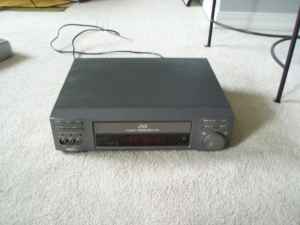Videocassette Recorder

Videocassette Recorder ("VCR" for short) is now-old technology used to supply video for personal use, allowing people to watch television programs they have recorded and pre-recorded movies, most prominently in the VHS format.
Videotape has been around since the 1950s, and the first cassette-based systems came out in the early 1970s (Sony's U-matic in 1971, Avco's Cartrivision and Philips' VCR in 1972), but it wasn't until 1975 that the first format to achieve any popularity, Betamax (a downsized, simplified version of U-matic), was introduced by Sony. JVC came out with VHS in 1976 in Japan, and RCA and Panasonic brought it to the US a year later; VHS became much more popular due to the 2 hour recording time (twice that of the first Betamax) and lower price. Sony would retaliate with x2 (later named BII) and x3 (BIII), but Panasonic and RCA had created a 4-hour speed on their machine, and JVC introduced a 6-hour speed (EP/SLP), but stopped there due to issues with quality and tracking. JVC also licensed the technology to many other companies (Magnavox, Sharp, Panasonic, RCA, GE, Emerson, etc.), which allowed for many more machines to be produced. Despite Beta's higher audio/video quality and the introduction of "Beta hi-fi" (copied by VHS with linear stereo, and then with "VHS hi-fi" which worked similarly to the Beta version, but recorded the signal onto the tape differently), their high price and shorter run time made Beta obsolete by the 90s. Rumor has it that the porno industry's preference for VHS is the main factor for Beta's failure in the 80s.
While Betamax itself has been dead for years (Sony kept it on life support in Japan until 2002, but popular support for it elsewhere had evaporated a good decade before that), the professional Betacam variants of the format have remained in use well into the HD era, and are only now starting to be replaced with more modern Flash Memory and hard disk formats. As for VHS, its high-end formats (Super VHS, W-VHS and D-VHS) never caught on the way Betacam did, and when the broadcast industry started switching to digital in the mid-1990s, they generally chose DV instead. U-matic, Beta's parent format, was never popular for home use, but saw a lot of usage in professional circles and in places like school libraries; it was eventually replaced in those roles by VHS (for educational and low-end commercial use) and Betacam.
For pre-recorded material such as films from Hollywood, it has all but been supplanted by the DVD player, but for people recording their own programs such as for time shifting (recording a show and viewing it later), the VCR is still heavily in use. The VCR is being slowly supplanted by DVRs (such as TiVo and ReplayTV) and DVD recorders, many of which use special services which spoon out TV Guide-type schedule listings for the machines to automatically record programs with. The primary remaining stronghold of the VCR is the camcorder, in which hard disks and optical discs have proven too sensitive to rough handling and solid state storage costs far too much at videotape's 25GB+ capacities (though ever-dropping SDCard prices and dual-mode still picture/motion video digital cameras are threatening to make camcorders obsolete).
Another good reason to keep an old VCR around is old movies that you find at the thrift store for $1 or less. Sure you could probably download them if you wanted to, but if you're already going to a thrift store anyway, the impulse-buy convenience of it all is worth the dollar. (Not to mention that some of these are older titles and/or are so rare that they will never be made available on DVD.) Alternatively, if you just want to play the tapes, there are devices available for only about $5 or so that are capable of playing cassette tapes, but don't have any recording capability. These are called VCPs, and some video-rental stores in the US, at least, used to rent them out alongside the tapes if you needed one.
Because of the large data storage capacity of VCR tapes, they were also occasionally used as the basis for computer data backup systems and one or two rare consoles. They were also instrumental in the development of the Compact Disc, which used a specially-modified U-matic recorder for master tapes because no one made a hard drive big enough at the time.
And finally, a bit of trivia: the last major motion picture released on VHS was the 2005 David Cronenberg thriller A History of Violence.